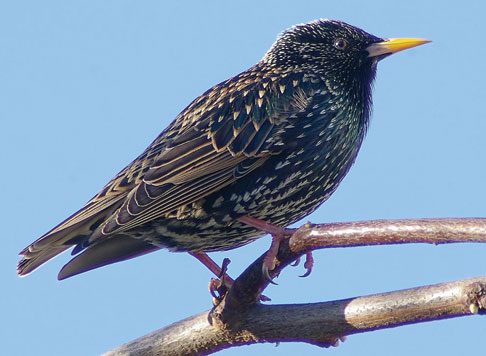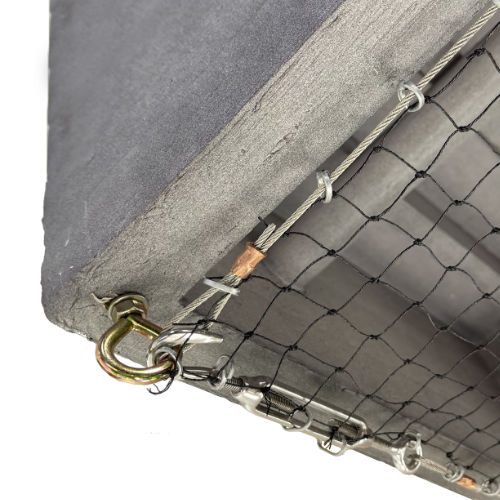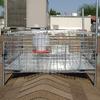Starling Control: How to Get Rid of Starlings

You are not alone. European Starlings (Sturnus vulgaris) are one of the worst (and most hated) nuisance birds in the U.S. This non-native, invasive species has spread across rural and urban North America. When starlings are in a flocking phase, large numbers, sometimes even thousands of these birds (sometimes called a murmuration) can overwhelm industrial facilities, airports, farms, orchards, parking lots, parks, airports, golf courses, and residential neighborhoods, causing a variety of problems:
- Large-scale buildup of feces from these flocks can lead to structural damage, as the uric acid in starling feces can damage paint, plastic, canvas canopies and other materials. corrode stone, metal, and masonry.
- Gutters and drainage pipes clogged with starling nests often back up, causing extensive water damage.
- Exhaust vents and ductwork are a favorite starling nesting place, which can cause indoor air quality problems and fire hazards.
- Bacteria, fungal agents, and parasites in starling feces pose a health risk.
- Starlings are an agricultural pestilence that eat and damage crops.
- Starlings are such a threat to airplanes that they are sometimes called “flying bullets.”
- Starlings can cause costly problems for cattle and swine producers as flocks eat high-protein supplements that are added to livestock feed and spread viruses between livestock facilities.
- Accumulations of starling feces cause slip and fall hazards.
Bird Barrier offers a number of high-quality starling control solutions including bird traps, deterrents, and repellents. With the right starling control products, you can solve any starling problem for good. We are here to help! Tell us about your starling problem and we’ll point you to the solutions you need.
Need help identifying Starlings?
Effective Starling Control Products: Choose the Right Trap, Repellent, or Deterrent
Total and permanent starling removal may require a long-term management plan, including a variety of products and approaches to the problem. Some of our most popular products for getting rid of starlings include:
- Bird-Shock Flex-Track (deters starlings by delivering an electric shock on contact)
- BirdSlide (prevents starlings from getting a grip on a ledge so they slide off!)
- StealthNet (exclusion bird netting made of polyethylene twine, keeps starlings out. In many situations, the best solution for starling problems is prevention with complete exclusion with 1-1/8″ mesh netting.)
- Optical Gel (a full sensory deterrent)
- Bird-Gard (an audio device that scares starlings)
- Starling traps (trapping is a last resort. We recommend trying all other applicable starling solutions before installing traps).
Recommended Products
Bird-Shock® Flex-Track™
A low-profile, electrified, ledge deterrent system that is effective against all species of birds.
Bird Traps™
Bird Barrier offers a variety of traps for safe removal of birds from a location.
StealthNet®
The strongest, most versatile bird exclusion system. StealthNet bird netting denies birds access to any architecture.
BirdSlide™
All bird species simply can’t get a grip and slide right off the ledge. Inverted, it prevents swallow nests.
Starling Traps
If you have tried all other possible solutions and have not been able to get your starling problem under control, trapping is an option. Bird Barrier offers a heavy duty, humane Starling Trap. Designed with a 1/4” and 1” rod frame and 14 gauge welded wire, this starling trap is spacious enough for birds to fly around inside until they can be released. Simply bait starling traps with suet, safflower seeds, sunflower seeds, cracked corn, or another type of food that starlings love, and wait. The birds will be safe and comfortable inside the trap until they can be released in another location. Options for shade and water are available.
Starlings are not protected by federal law. State laws concerning starlings may vary so always consult your local wildlife agency before trapping these birds. Keep in mind that lethal starling control methods such as shooting or poisoning may be outlawed in your area, even if trapping is legal. In many cases, other starling deterrents will be a better management solution than trapping. If you are unsure whether or not to use traps or which starling trap is right for your situation, contact Bird Barrier’s customer support team for expert advice.
Starling Deterrents: Audio, Visual, and Other Repellents
For large flocks or agricultural applications, starlings can be removed or deterred with a well-timed, organized scare campaign using strategically placed sophisticated audio or visual repellents, as well as deterrents that irritate the starlings’ other senses. Options include:
Optical Gel
Optical Gel is a humane audio and visual bird control product that deters starlings from landing or roosting on edges, signs, balconies, soffits, beams, skylights, signs, roofs, AC equipment, and enclosed spaces without harming them. OpticalGel repels starlings by tricking them into thinking they see fire or smoke, while emitting the scent of peppermint oil (which they hate). Simply glue Optical Gel dishes 8 inches apart along the surface you wish to protect from starlings. Once applied, starlings will desert the site, even one they have been using for years. Optical Gel is the best starling control solution for sites where mechanical deterrents can’t be used.
Bird-Gard
Audio deterrents repel starlings by combining natural and electronic sounds like species specific distress calls, predator hunting/attack sequences, and cannon or shotgun sounds. Bird-Gard is a programmable electronic audio repeller that is the ideal solution for spot dispersal of flocking starlings in small areas. Pro #1 Bird-Gard was designed to repel starlings by emitting distress signals and predator calls that frighten starlings. The birds hear the “danger” and send an alert to other starlings in the area to stay away.
Avian Control®
For wooded areas, airplane hangars, grassy fields, golf courses, or large properties, we recommend Avian Control® as a large-scale starling repellent. This product is an EPA-registered liquid bird repellent (approved for use on numerous crops) that can be applied by fogging or spraying. This humane means of control is effective against starlings without harming birds, humans, livestock, or household pets. While non-lethal to birds, it acts as an irritant, discouraging birds from amassing.
Starling Prevention
If possible, the best approach is to prevent starlings from roosting on your property before they build nests. Here are a few steps you can take to prevent starlings from roosting or nesting in your buildings or on your land.
1. Remove all food sources from the site (this includes everything from bird feeders to unsecured dumpsters, garbage cans, livestock feeding equipment, and pet food containers). If you insist on having a bird feeder, purchase a starling proof bird feeder and avoid nyler seed which is often more attractive to problem birds than blue jays or other types of backyard birds you want to attract.
2. To prevent starlings from entering a building, seal any openings over one inch in diameter (check all vents, ducts, and windows).
3. Prune trees on the property to make the land less attractive to starlings as a roosting spot.
4. Install 1-1/8″ mesh StealthNet exclusion netting on the underside of roof beams inside open buildings, such as livestock sheds, barns, and airplane hangars.
If these pest birds have already started flocking, roosting, or nesting on your property, we can help. Bird Barrier offers a number of solutions designed to deter and repel starlings.
Professional Installation of Starling Control Products and Systems
Our library of videos will help you learn how to install our starling control products including:
- StealthNet
- Bird-Shock Flex Track
- Optical Gel
Whether you are a professional installer or searching for a starling control system for your own business, farm, or home, our staff is here to give you expert bird control advice, no matter the size of your site or the scope of the problem. Give us a call or email. We’ll provide customized support on how to plan, order, and install a bird control system designed for your starling problems.
Starling Behavior
Like the house sparrow, the starling was introduced from Europe in the 19th century. Starlings are well adapted to urban life, which offer it an abundance of food and nesting sites. Starlings are very aggressive and will drive native birds out of their territory, much to the dismay of local bird watchers. Starlings are well noted for their flocking habits. They often gather in the tens of thousands, creating a nuisance when roosting in populated areas.
Identifying Starlings
The starling is a dark, chunky, muscular bird about eight inches long with long wings and a short squared tail. The starling is a distinguished from other blackbirds by its short tail and its longer, slender bill. Starling plumage varies depending on the season. In winter, the bird displays a highly speckled iridescent coat and a dark bill. In summer, the bird’s coat dulls and has far fewer speckles.
Info on Starling Nesting and Breeding Patterns and Behavior
Starling Nesting
The Starling is a nesting bird. Their nests are in enclosed areas with at least a 1-1/2 inch opening. Starlings prefer to nest in old trees, church steeples, and other holes and crevices. Due to their bullying nature they will take any suitable site, evicting any previous owner. They sometimes watch other birds build a complete nest before forcing them to leave.
Starlings are so aggressive that they will out-compete native cavity-nesting species—such as bluebirds and Red-headed Woodpeckers—so your birdhouses are likely to home them instead of any birds you might want to attract. Starlings are considered one of the most destructive birds when it comes to native songbirds.
Starling Breeding
Starlings have two broods a year with four to five eggs a brood. They average eight offspring a year. The eggs are white, pale blue, or green-white. Incubation of the eggs takes 12 days. The fledglings leave the nest after 25 days. The young leave to join other juveniles and form huge flocks that move on to other territories.
Starling Cycles
In southern (or warmer) climates, starlings tend to stay put, whereas many northern starlings will migrate south in fall. Starlings often become a bigger urban pest in the colder months, as they move from rural trees to warm city buildings and stay throughout the winter. Starlings migrate by day—their daily cycle is to leave at sunrise. They will travel up to 60 miles to feeding areas before returning to their nesting sites for the evening. They disperse to mate in the spring. After mating season, they will often coalesce into huge flocks with defined feeding and roosting areas.






